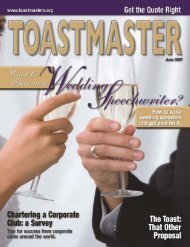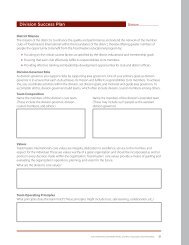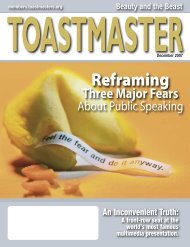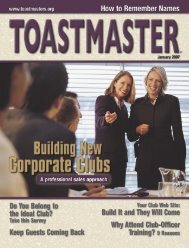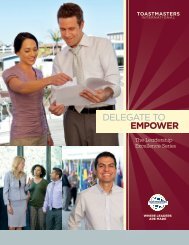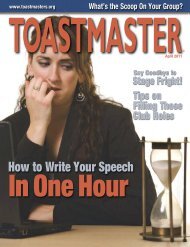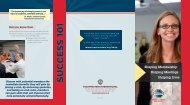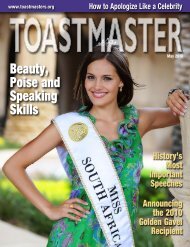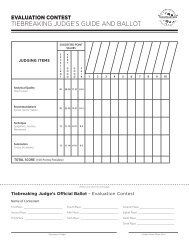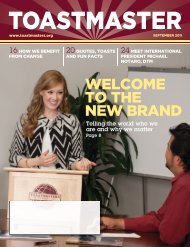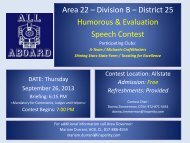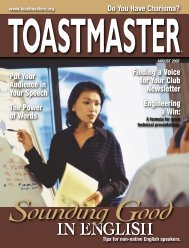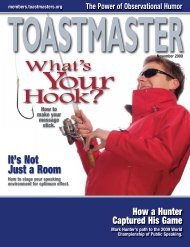Motivating Achievement - Toastmasters International
Motivating Achievement - Toastmasters International
Motivating Achievement - Toastmasters International
Create successful ePaper yourself
Turn your PDF publications into a flip-book with our unique Google optimized e-Paper software.
MOTIVATING<br />
ACHIEVEMENT<br />
Club Leadership<br />
Training Session<br />
WHERE LEADERS<br />
ARE MADE
Club Leadership Training Session<br />
THE MISSION OF THE CLUB<br />
The mission of a <strong>Toastmasters</strong> club is to provide a mutually<br />
supportive and positive learning environment in which<br />
every individual member has the opportunity to develop<br />
oral communication and leadership skills, which in turn<br />
foster self-confidence and personal growth.<br />
MOTIVATING<br />
ACHIEVEMENT<br />
TOASTMASTERS<br />
INTERNATIONAL<br />
P.O. Box 9052 • Mission Viejo, CA 92690 USA<br />
Phone: 949-858-8255 • Fax: 949-858-1207<br />
www.toastmasters.org/members<br />
WHERE LEADERS<br />
ARE MADE<br />
© 2011 <strong>Toastmasters</strong> <strong>International</strong>. All rights reserved. <strong>Toastmasters</strong><br />
<strong>International</strong>, the <strong>Toastmasters</strong> <strong>International</strong> logo, and all other<br />
<strong>Toastmasters</strong> <strong>International</strong> trademarks and copyrights are the sole property<br />
of <strong>Toastmasters</strong> <strong>International</strong> and may be used only with permission.<br />
Rev. 3/2011<br />
Item 1311D
TABLE OF CONTENTS<br />
Club Leadership Training Session .................................................. 4<br />
Conducting the Session . . . . . . . . . . . . . . . . . . . . . . . . . . . . . . . . . . . . . . . . . . . . . . . . . . . . . . . . . . 4<br />
In Your Own Words .............................................................. 4<br />
Using Visual Aids Effectively ..................................................... 4<br />
How to Use the Outline ......................................................... 5<br />
Checklist for Training ............................................................ 5<br />
Evaluation and Follow-up ....................................................... 5<br />
Outline .............................................................................. 6<br />
Introduction .................................................................... 6<br />
Session Topics ................................................................... 6<br />
Communication and Leadership Tracks .......................................... 6<br />
Awards and Recognition ........................................................ 7<br />
Membership Building ........................................................... 8<br />
Club-building Assistance ........................................................ 9<br />
<strong>Motivating</strong> Individual <strong>Achievement</strong> ............................................ 10<br />
Closing ........................................................................ 11<br />
Evaluation ..................................................................... 15<br />
MOTIVATING ACHIEVEMENT 3
CLUB LEADERSHIP<br />
TRAINING SESSION<br />
The club is the heart of the <strong>Toastmasters</strong> program. It provides the environment and support members<br />
need to develop their communication and leadership skills. Club officers support the club and<br />
sustain consistent club quality to keep members satisfied. In order for a club to be successful, club<br />
officers must know their roles and responsibilities. That’s why this training session is so important: it<br />
identifies performance standards and describes how to achieve them.<br />
The cornerstone of a good training session is preparation. A good presenter of a club officer training<br />
session is familiar with the Club Officer Handbook (Item 1310). This item is available online at<br />
www.toastmasters.org/clubofficerroles.<br />
Training does not end with the training session. It is a process that continues throughout an officer’s<br />
term. Let your trainees know the area governor and district leaders are all available to help if questions<br />
arise during their term of office, and provide them with area and division governor contact<br />
information for their respective clubs.<br />
CONDUCTING THE SESSION<br />
Joining a <strong>Toastmasters</strong> club may be easy; to practice giving speeches may not be. As club officers,<br />
it is vital to motivate each member to meet and exceed their potential through the <strong>Toastmasters</strong><br />
educational program. This training session discusses how to motivate members through the<br />
<strong>Toastmasters</strong> educational program which strengthens the club and develops the member.<br />
This product consists of three parts:<br />
1. Definition and explanation of the session<br />
2. A training outline<br />
3. A PowerPoint presentation to be viewed along with the session<br />
IN YOUR OWN WORDS<br />
The outline is not a script and should not be read word-for-word. Instead, use the document<br />
as a guide for presenting the material with your own narrative style. This training<br />
session may be modified by each district as necessary.<br />
USING VISUAL AIDS AND HANDOUTS EFFECTIVELY<br />
Visual aids and handouts add interest and help your audience retain information. You are encouraged<br />
to use them. If you plan to use the PowerPoint slides for this session as visual aids, you will<br />
need a data projector, a laptop computer, a table to support them, and a screen for viewing. In<br />
the outline, in the right-hand column, are indications for placement of the PowerPoint slides and<br />
distribution of handouts. Each is numbered. Please note that the first slide in the PowerPoint show<br />
is a title slide and is not included in this numbering system.<br />
MOTIVATING ACHIEVEMENT 4
If you cannot arrange for projection equipment but still would like to use visuals, you may copy<br />
the material onto a flipchart. Do this before the presentation. Use a heavy marking pen that does<br />
not seep through the paper, and write on every third or fourth page so succeeding visuals will not<br />
show through. Also, make your letters large and heavy with plenty of space between them.<br />
Follow these tips when using visual aids:<br />
Set them up and test them before the meeting begins. Place them so they are easily visible<br />
to listeners. Place your projector so it projects a large, high, undistorted image on the screen.<br />
Focus the image.<br />
Bring spare equipment, such as a projector bulb, extension cord, and extra marking pens.<br />
Display your visuals only when they are needed. If you are using a flipchart, flip the page back<br />
out of view when you are finished with it.<br />
Remember not to stand between the screen or flipchart and your audience or you will block<br />
their view.<br />
Maintain eye contact with your listeners. Do not talk to the screen or flipchart. If you must turn<br />
your back to point out something, pause as you point it out, and then resume speaking only<br />
when facing your audience again.<br />
HOW TO USE THE OUTLINE<br />
As you prepare for the session, keep two things in mind:<br />
1. Fit your planned discussion into the time allocated.<br />
2. Allow ample time for group discussion and participation.<br />
Mention that trainees can find information on all of the duties of office in their club officer manual.<br />
Urge them to use the Web Resources page in the Appendix of their officer manual.<br />
CHECKLIST FOR TRAINING<br />
____ Visual aids prepared<br />
____ Room arranged and properly equipped<br />
____ Supplies and reference materials on hand<br />
____ Laptop and projector available<br />
____ Flipchart, easel, and marking pens available<br />
____ Notepads and pencils available for each participant<br />
EVALUATION AND FOLLOW-UP<br />
Ask the participants to fill out the evaluation form at the end of the session. Use this information in<br />
planning future sessions.<br />
Evaluate the use of materials. Be sure to follow up with the club leaders throughout their term. Keep<br />
in mind that learning is a continuous process. Hold formal or informal review sessions as frequently<br />
as possible. If necessary, hold a make-up session for those who were unable to attend.<br />
MOTIVATING ACHIEVEMENT 5
OUTLINE<br />
Trainer: Welcome the club officers, mention training length, location of restrooms, ask for<br />
cell phones to be silenced, etc. Remember, time is precious and must be controlled carefully.<br />
V1<br />
INTRODUCTION<br />
Becoming a Toastmaster is a comparatively effortless way to build speaking and leadership skills.<br />
Joining a club, however, does not automatically guarantee success. It is simply the first step toward<br />
that goal. Any type of achievement takes continued effort on the part of the individual. <strong>Achievement</strong><br />
also must be encouraged and motivated. When individual members achieve, the entire club<br />
benefits. Individual member achievements often determine whether the club will be recognized in<br />
the Distinguished Club Program.<br />
V2<br />
SESSION TOPICS<br />
The ability to motivate members is a key element in a successful <strong>Toastmasters</strong> club. As officers, one<br />
of the most important responsibilities is to motivate fellow members toward achieving their goals.<br />
This can happen once we are aware of the many possibilities participation offers.<br />
The communication and leadership tracks<br />
Membership building<br />
Club building<br />
<strong>Motivating</strong> individual achievement<br />
V3<br />
COMMUNICATION AND LEADERSHIP TRACKS<br />
The educational program is the heart of the <strong>Toastmasters</strong> club. It is divided into two tracks – a communication<br />
track and a leadership track. The tracks are not mutually exclusive. Members can work<br />
in both tracks at the same time to receive the full benefits <strong>Toastmasters</strong> has to offer. It is important<br />
to motivate each member through these two tracks.<br />
Communication Track<br />
■■<br />
The core of this track is the Competent Communication manual<br />
■■<br />
Advanced Communicator Bronze<br />
■■<br />
Advanced Communicator Silver<br />
■■<br />
Advanced Communicator Gold<br />
Leadership Track<br />
■■<br />
The core of this track is the Competent Leadership manual<br />
■■<br />
Advanced Leader Bronze<br />
■■<br />
Advanced Leader Silver<br />
■■<br />
Distinguished Toastmaster<br />
MOTIVATING ACHIEVEMENT 6
Trainer: For more detailed information on these two tracks, please visit<br />
www.toastmasters.org/educationprogram.<br />
To apply for any award, members should complete the appropriate section of the awards application.<br />
Applications are available as PDFs online. The vice president education or other current club<br />
officer can then submit the application online through the <strong>Toastmasters</strong> website,<br />
www.toastmasters.org, or mail the application to World Headquarters. Members receiving CC, AC,<br />
CL, or AL awards will receive a certificate and, if they wish, World Headquarters will send a letter to<br />
their employer about their achievement. Members receiving the Distinguished Toastmaster award<br />
receive a plaque and mention in the Toastmaster magazine. World Headquarters can send a letter<br />
to their employer about their achievement, as well.<br />
V4<br />
V5<br />
AWARDS AND RECOGNITION<br />
Some members may question the necessity of earning awards. They enjoy attending meetings,<br />
assuming various meeting roles, and even occasionally giving a speech, but they seem ambivalent<br />
about working in the manuals. When asked how far they are away from achieving an award, the<br />
response is something like, “I’m not really sure, but why earn awards anyway I’m comfortable with<br />
the way things are now.”<br />
Feeling comfortable in a <strong>Toastmasters</strong> club is, of course, half of the battle. However, a battle half<br />
fought does not equal victory. Eventually each Toastmaster must step outside his or her comfort<br />
zone and take some necessary risks. Working through the manuals provides an excellent safety net<br />
for those ready to take risk; completion of the manuals signifies the victory.<br />
Why earn awards<br />
■■<br />
Increases self-confidence and poise<br />
■■<br />
Improves speaking and leadership skills<br />
■■<br />
Creates more opportunities to speak inside and outside of <strong>Toastmasters</strong><br />
Getting members involved<br />
For example:<br />
You have probably heard a number of reasons people delay in giving the next speech or<br />
assuming a harder meeting role. They may say, “I want my next project to be perfect, so<br />
I’m taking extra time,” or, “I have too much going on at work right now– I’ll let you know<br />
when I’m ready.”<br />
V6<br />
■■<br />
Offer assistance to any member who wavers when committing to a specific date for<br />
completing a manual project.<br />
■■<br />
Often, you can provide solutions to concerns that have gone unvoiced.<br />
Additional incentives to recognize members at club level<br />
■■<br />
VPE is in an excellent position to congratulate club members.<br />
■■<br />
Publish educational achievements in your club newsletter.<br />
■■<br />
Publish educational achievements on the club’s website.<br />
■■<br />
Publicize achievements at area and district levels.<br />
MOTIVATING ACHIEVEMENT 7
V7<br />
■■<br />
Hold recognition ceremonies.<br />
■■<br />
Present special tokens of recognition.<br />
Keep members aware of continued opportunities by<br />
■■<br />
Becoming familiar with other projects<br />
For example:<br />
Advanced manuals<br />
Speechcraft<br />
Success/Communication Series and<br />
Success/Leadership Series modules<br />
The Better Speaker Series<br />
The Successful Club Series<br />
The Leadership Excellence Series<br />
■■<br />
Reading The Leadership Excellence Series, particularly “<strong>Motivating</strong> People” (Item 319)<br />
H1<br />
Case Study 1<br />
Recognizing Educational <strong>Achievement</strong>s<br />
Trainer: How do clubs recognize educational achievement<br />
Objective:<br />
Time:<br />
Process:<br />
To help leaders brainstorm ideas and activities that will motivate club members<br />
to achieve educational goals by recognizing their achievements.<br />
10 minutes<br />
Ask, “How does your club recognize member achievement How much<br />
would you like to recognize achievement in the upcoming year”<br />
For a group numbering less than 10 people:<br />
Hold a question-and-answer session. Allow the entire group to make suggestions. Record<br />
them on a flipchart or white board, if possible.<br />
For a group numbering more than 10 people:<br />
Have everyone form groups of three or four to discuss their ideas for five minutes. Each<br />
group should have one person make note of the major discussion points. They may wish<br />
to use the extra space on the handout to write. Another person should report these ideas<br />
to the entire audience afterward. Record all of the ideas on a flipchart or white board, if<br />
possible.<br />
V8<br />
MEMBERSHIP BUILDING<br />
One of the most important responsibilities during the term as a club officer will be your ability to<br />
motivate membership building. By networking with the vice president membership and other officers,<br />
you can discover some excellent methods of inspiring fellow club members to bring in guests<br />
and attract the attention of those unfamiliar with the benefits of being a Toastmaster.<br />
There are some steps that can be taken beforehand.<br />
Step 1: Set realistic goals<br />
For example:<br />
A club could decide to add at least one new member a month.<br />
V9<br />
Step 2: Conduct a Speechcraft<br />
Speechcraft is a speech-training workshop that will bring prospective new members into the club<br />
MOTIVATING ACHIEVEMENT 8
V10<br />
to see what <strong>Toastmasters</strong> is all about. The workshop can be presented either as an integral part<br />
of the club meeting or as an outside-the-club seminar. The Speechcraft Starter Kit contains all the<br />
material needed to conduct the program for five participants, including complete instructions for<br />
you, the coordinator.<br />
■■<br />
Speechcraft Starter Kit (Item 205)<br />
■■<br />
An Opportunity to Succeed (Item 207)<br />
■■<br />
Speechcraft Promotional Kit (Item 203)<br />
■■<br />
www.toastmasters.org/speechcraft<br />
Step 3: Plan a membership-building contest (www.toastmasters.org/membershipcontests)<br />
■■<br />
Annual Membership Program: Members who sponsor 5 or 10 new, dual, or reinstated<br />
members will qualify for one of two Membership Building pins; sponsors of 15 new members<br />
will qualify for their choice of a <strong>Toastmasters</strong> necktie or ascot scarf.<br />
■■<br />
Smedley Award: Clubs that add 5 or more members during August and September receive<br />
a “Smedley Award” ribbon for their club banner. In addition to the ribbon, qualifying clubs<br />
will also earn a special discount code for 10% off their next club order.<br />
■■<br />
Talk Up <strong>Toastmasters</strong>: Clubs that add 5 or more new, dual or reinstated members during<br />
February and March receive a “Talk Up <strong>Toastmasters</strong>!” ribbon to display on the club banner. In<br />
addition to the ribbon, qualifying clubs will also earn a special discount code for 10% off their<br />
next club order.<br />
■■<br />
Beat the Clock!: Clubs that add 5 new, dual, or reinstated members between May 1 and June<br />
30 receive a “Beat the Clock” ribbon to display on the club’s banner. In addition to the ribbon,<br />
qualifying clubs will also earn a special discount code for 10% off their next club order.<br />
V11<br />
CLUB-BUILDING ASSISTANCE<br />
Membership levels are not the only issue of importance in the development and care of a <strong>Toastmasters</strong><br />
club. Sometimes the club itself needs assistance in order to evolve or grow.<br />
<strong>Toastmasters</strong> who help other clubs by acting as sponsors, mentors, and coaches deserve special<br />
accolades for their efforts and dedication.<br />
Club Sponsors: Those who play a part in founding a new club<br />
Club Mentors: Those who help a club through its first six months<br />
Club Coaches: Those who are advisors and troubleshooters for clubs with 12 or fewer members<br />
that need them<br />
H2<br />
Case Study 2<br />
Help Clubs Plan for Membership Building<br />
Objective:<br />
Time:<br />
Process:<br />
To encourage ideas and activities that will motivate clubs with membership<br />
building.<br />
10 minutes<br />
Ask: “How has your club encouraged membership building in the past<br />
What types of membership-building activities will your club find useful during<br />
the current club year”<br />
MOTIVATING ACHIEVEMENT 9
For a group numbering less than 10 people:<br />
Hold a question-and-answer session. Allow the entire group to make suggestions. Record<br />
them on a board, if possible.<br />
For a group numbering more than 10 people:<br />
Have everyone form groups of three or four to discuss their ideas for five minutes. Each<br />
group should have one person write down the major discussion points and another person<br />
report these ideas to the entire audience afterward. Record all of the ideas on a board,<br />
if possible.<br />
V12<br />
MOTIVATING INDIVIDUAL ACHIEVEMENT<br />
Aside from fulfilling basic executive responsibilities, one of your most critical obligations as a club<br />
officer will be inspiring your fellow members to achieve their own personal goals as active club<br />
participants.<br />
Recognize Immediately.<br />
■■<br />
Sometimes an unexpected brief but sincere compliment, a smile, or a handshake is all someone<br />
needs to feel appreciated.<br />
■■<br />
Set aside some time to make announcements of individual achievements.<br />
For example:<br />
Post an announcement on the club website for individuals who completed their CC Award.<br />
V13<br />
H3<br />
Acknowledge personal milestones.<br />
■■<br />
E.g. birthdays, birth of children, promotion at work, purchase of new home<br />
■■<br />
VPPR is in excellent position to publicize achievements, though all club officers should make<br />
an effort to recognize club members on their accomplishments.<br />
Recognize in print.<br />
■■<br />
Club newsletter<br />
■■<br />
Inform editors of area and district publications.<br />
Recognize online.<br />
■■<br />
Club website<br />
■■<br />
Club mailing list<br />
Case Study 3<br />
How do clubs recognize individual achievement<br />
Objective:<br />
Time:<br />
Process:<br />
To encourage club officers to plan new and better motivational strategies to<br />
help foster personal growth in active club members.<br />
10 to 15 minutes<br />
Divide the group in half. Assign the following discussions:<br />
Group A – First half of the trainees:<br />
Discuss motivational awards and incentives that you have personally received over the<br />
years. Which have worked the best in motivating you to reach for new goals Choose one<br />
person to write a list of the items discussed. If possible, use a whiteboard or flipchart to<br />
record the list.<br />
MOTIVATING ACHIEVEMENT 10
Group B – Second half of the trainees:<br />
Discuss motivational awards and incentives that you have used in a club/area/district officer<br />
role.<br />
■■<br />
Which of these have been the easiest to arrange<br />
■■<br />
Which have been the most challenging<br />
■■<br />
Which have garnered the strongest reactions from the recipients of these awards<br />
Choose one person to record three sections: 1. Easier, 2. More challenging, 3. Strongest<br />
reactions. If possible, use a whiteboard or flipchart to record the three lists.<br />
After a five- to 10-minute discussion, help the two groups compare notes. If possible, place<br />
the lists near each other to compare answers from Group A with answers from Group B.<br />
V14<br />
CLOSING<br />
Even if club members tend to be self-starters with clear-cut goals and objectives, they still need to<br />
be motivated and inspired throughout the term. Take time to become familiar with the many program<br />
opportunities offered by <strong>Toastmasters</strong> <strong>International</strong>. Encourage members to go beyond basic<br />
participation, and network with fellow officers to present the best programs possible. Be accessible,<br />
and remember that both long- and short-term goals need reinforcement and reassurance. One of<br />
the most important advantages of learning with a group of like-minded individuals is the mutually<br />
supportive atmosphere. As an officer, take pride in motivating your members!<br />
MOTIVATING ACHIEVEMENT 11
Handout 1<br />
Case Study 1<br />
Recognizing Educational <strong>Achievement</strong>s<br />
Trainer: How do clubs recognize educational achievement<br />
Objective:<br />
Time:<br />
Process:<br />
To help leaders brainstorm ideas and activities that will motivate club members<br />
to achieve educational goals by recognizing their achievements.<br />
10 minutes<br />
Ask, “How does your club recognize member achievement How much<br />
would you like to recognize achievement in the upcoming year”<br />
For a group numbering less than 10 people:<br />
Hold a question-and-answer session. Allow the entire group to make suggestions. Record<br />
them on a flipchart or white board, if possible.<br />
For a group numbering more than 10 people:<br />
Have everyone form groups of three or four to discuss their ideas for five minutes. Each<br />
group should have one person make note of the major discussion points. They may wish<br />
to use the extra space on the handout to write. Another personshould report these ideas<br />
to the entire audience afterward. Record all of the ideas on a flipchart or white board, if<br />
possible.<br />
MOTIVATING ACHIEVEMENT 12
Handout 2<br />
Case Study 2<br />
Help Clubs Plan for Membership Building<br />
Objective:<br />
Time:<br />
Process:<br />
To encourage ideas and activities that will motivate clubs with membership<br />
building.<br />
10 minutes<br />
Ask: “How has your club encouraged membership building in the past<br />
What types of membership-building activities will your club find useful during<br />
the current club year”<br />
For a group numbering less than 10 people:<br />
Hold a question-and-answer session. Allow the entire group to make suggestions. Record<br />
them on a board, if possible.<br />
For a group numbering more than 10 people:<br />
Have everyone form groups of three or four to discuss their ideas for five minutes. Each<br />
group should have one person write down the major discussion points and another person<br />
report these ideas to the entire audience afterward. Record all of the ideas on a board,<br />
if possible.<br />
MOTIVATING ACHIEVEMENT 13
Handout 3<br />
Case Study 3<br />
How do clubs recognize individual achievement<br />
Objective:<br />
Time:<br />
Process:<br />
To encourage club officers to plan new and better motivational strategies to<br />
help foster personal growth in active club members.<br />
10 to 15 minutes<br />
Divide the group in half. Assign the following discussions:<br />
Group A – First half of the trainees:<br />
Discuss motivational awards and incentives that you have personally received over the<br />
years. Which have worked the best in motivating you to reach for new goals Choose one<br />
person to write a list of the items discussed. If possible, use a whiteboard or flipchart to<br />
record the list.<br />
Group B – Second half of the trainees:<br />
Discuss motivational awards and incentives that you have used in a club/area/district officer<br />
role.<br />
■■<br />
Which of these have been the easiest to arrange<br />
■■<br />
Which have been the most challenging<br />
■■<br />
Which have garnered the strongest reactions from the recipients of these awards<br />
Choose one person to record three sections: 1. Easier, 2. More challenging, 3. Strongest<br />
reactions. If possible, use a whiteboard or flipchart to record the three lists.<br />
After a five- to 10-minute discussion, help the two groups compare notes. If possible, place<br />
the lists near each other to compare answers from Group A with answers from Group B.<br />
MOTIVATING ACHIEVEMENT 14
EVALUATION FORM<br />
Date: ______________________________ Session Name: _______________________________________________<br />
Facilitator: _____________________________________________________________________________________<br />
On a scale of one to five, five being the highest rating, please rate the course and facilitator on the following items by<br />
circling the number you find most appropriate:<br />
1. How relevant was this session to your job in <strong>Toastmasters</strong> 1 2 3 4 5<br />
2. Rate the following:<br />
Course 1 2 3 4 5<br />
Facilitator 1 2 3 4 5<br />
Activities/Exercises 1 2 3 4 5<br />
3. Were the objectives clearly stated 1 2 3 4 5<br />
4. How was the lesson plan organized 1 2 3 4 5<br />
5. Did the instructional methods clearly illustrate the instructor’s plan 1 2 3 4 5<br />
6. To what extent did the visual aids add to your understanding of the presentation 1 2 3 4 5<br />
7. How were the meeting facilities 1 2 3 4 5<br />
8. What are two things you learned that will make you a more effective club officer<br />
Additional Comments:<br />
MOTIVATING ACHIEVEMENT 15



